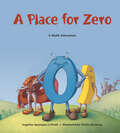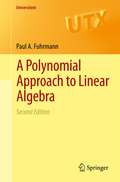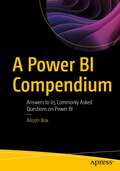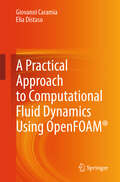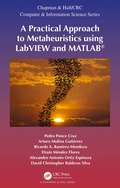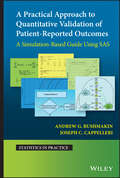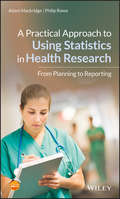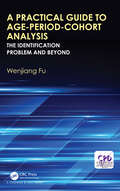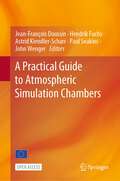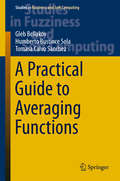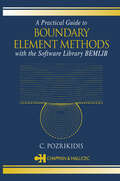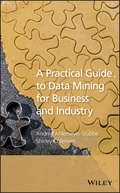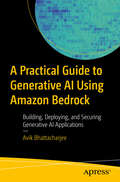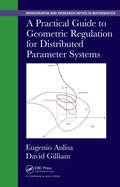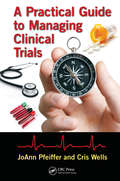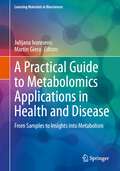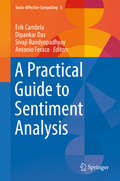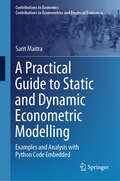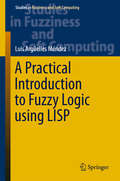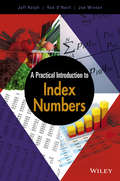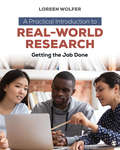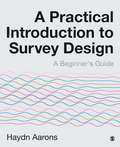- Table View
- List View
A Place for Zero (Charlesbridge Math Adventures)
by Angeline Sparagna LoPrestiJoin Zero on his math adventure as he discovers his place through multiplication. Zero is lonely in Digitaria. He can't play Addemup with the other numbers because he has nothing to add. All the other numbers seem to belong and they all have a place, but when zero discovers multiplication he thinks he might have a place there. He sets out to find King Multiplus who also is curious about what will happen when Zero gets thrown in the mix. With math and wordplay A Place for Zero is the perfect introduction to multiplication and number placement. A playful way to make math less intimidating and more fun to explore.
A Polynomial Approach to Linear Algebra (Universitext)
by Paul A. FuhrmannA Polynomial Approach to Linear Algebra is a text which is heavily biased towards functional methods. In using the shift operator as a central object, it makes linear algebra a perfect introduction to other areas of mathematics, operator theory in particular. This technique is very powerful as becomes clear from the analysis of canonical forms (Frobenius, Jordan). It should be emphasized that these functional methods are not only of great theoretical interest, but lead to computational algorithms. Quadratic forms are treated from the same perspective, with emphasis on the important examples of Bezoutian and Hankel forms. These topics are of great importance in applied areas such as signal processing, numerical linear algebra, and control theory. Stability theory and system theoretic concepts, up to realization theory, are treated as an integral part of linear algebra. This new edition has been updated throughout, in particular new sections have been added on rational interpolation, interpolation using H^{\nfty} functions, and tensor products of models. Review from first edition: "...the approach pursed by the author is of unconventional beauty and the material covered by the book is unique." (Mathematical Reviews)
A Portrait of America
by John IcelandPortrait of America describes our nation's changing population and examines through a demographic lens some of our most pressing contemporary challenges, ranging from poverty and economic inequality to racial tensions and health disparities. Celebrated authorJohn Iceland covers various topics, including America's historical demographic growth; the American family today; gender inequality; economic well-being; immigration and diversity; racial and ethnic inequality; internal migration and residential segregation; and health and mortality. The discussion of these topics is informed by several sources, including an examination of household survey data, and by syntheses of existing published material, both quantitative and qualitative. Iceland discusses the current issues and controversies around these themes, highlighting their role in everyday debates taking place in Congress, the media, and in American living rooms. Each chapter includes historical background, as well as a discussion of how patterns and trends in the United States compare to those in peer countries.
A Power BI Compendium: Answers to 65 Commonly Asked Questions on Power BI
by Alison BoxAre you a reasonably competent Power BI user but still struggling to generate reports that truly tell the story of your data? Or do you simply want to extend your knowledge of Power BI by exploring more complex areas of visualizations, data modelling, DAX, and Power Query? If so, this book is for you. This book serves as a comprehensive resource for users to implement more challenging visuals, build better data models, use DAX with more confidence, and execute more complex queries so they can find and share important insights into their data. The contents of the chapters are in a question-and-answer format that explore everyday data analysis scenarios in Power BI. These questions have been generated from the author’s own client base and from commonly sought-for information from the Power BI community. They cover a wide and diverse range of topics that many Power BI users often struggle to get to grips with or don’t fully understand. Examples of such questions are: How can I generate dynamic titles for visuals?How can I control subtotals in a Matrix visual?Why do I need a date dimension?How can I show the previous N month’s sales in a column chart?Why do I need a Star Schema?Why aren't my totals correct?How can I bin measures into numeric ranges?Can I import a Word document?Can I dynamically append data from different source files? Solutions to these questions and many more are presented in non-technical and easy-to-follow explanations negating the requirement to perform tiresome and fruitless “google” searches. There are also companion Power BI Desktop files that set out the answers to each question so you can follow along with the examples given in the book.. After working through this book, you will have extended your knowledge of Power BI to an expert level, alleviating your existing frustrations and so enabling you to design Power BI reports where you are no longer limited by your lack of knowledge or experience. Who is This Book For: Power BI users who can build reports and now want to extend their knowledge of Power BI.
A Practical Approach to Computational Fluid Dynamics Using OpenFOAM®
by Giovanni Caramia Elia DistasoThis book is designed for undergraduate and graduate engineering students who are encountering computational fluid dynamics for the first time in their study of fluid machines. The approach emphasizes a gradual and effective learning process, aiming to minimize the time required to attain a solid foundational understanding. Clarity of exposition is prioritized over strict mathematical rigor, with continuous reference to the physical significance of the mathematical formulas presented. This approach enables students to independently produce acceptable results for most case studies of general interest. The book provides a comprehensive collection of essential concepts needed for correctly configuring any computational fluid dynamics software. To enhance accessibility, it focuses on OpenFOAM, a free and open-source software renowned for its extensive community of developers and users.
A Practical Approach to Metaheuristics using LabVIEW and MATLAB® (Chapman & Hall/CRC Computer and Information Science Series)
by Pedro Ponce-Cruz Arturo Molina Gutiérrez Ricardo A. Ramírez-Mendoza Efraín Méndez Flores Alexandro Antonio Espinoza David Christopher SilvaMetaheuristic optimization has become a prime alternative for solving complex optimization problems in several areas. Hence, practitioners and researchers have been paying extensive attention to those metaheuristic algorithms that are mainly based on natural phenomena. However, when those algorithms are implemented, there are not enough books that deal with theoretical and experimental problems in a friendly manner so this book presents a novel structure that includes a complete description of the most important metaheuristic optimization algorithms as well as a new proposal of a new metaheuristic optimization named earthquake optimization. This book also has several practical exercises and a toolbox for MATLAB® and a toolkit for LabVIEW are integrated as complementary material for this book. These toolkits allow readers to move from a simulation environment to an experimentation one very fast. This book is suitable for researchers, students, and professionals in several areas, such as economics, architecture, computer science, electrical engineering, and control systems. The unique features of this book are as follows: Developed for researchers, undergraduate and graduate students, and practitioners A friendly description of the main metaheuristic optimization algorithms Theoretical and practical optimization examples A new earthquake optimization algorithm Updated state-of-the-art and research optimization projects The authors are multidisciplinary/interdisciplinary lecturers and researchers who have written a structure-friendly learning methodology to understand each metaheuristic optimization algorithm presented in this book.
A Practical Approach to Quantitative Validation of Patient-Reported Outcomes: A Simulation-based Guide Using SAS (Statistics in Practice)
by Joseph C. Cappelleri Andrew G. BushmakinA Practical Approach to Quantitative Validation of Patient-Reported Outcomes A Practical Approach to Quantitative Validation of Patient-Reported Outcomes A Simulation-Based Guide Using SASIn A Practical Approach to Quantitative Validation of Patient-Reported Outcomes, two distinguished researchers, with 50 years of collective research experience and hundreds of publications on patient-centered research, deliver a detailed and comprehensive exposition on the critical steps required for quantitative validation of patient-reported outcomes (PROs). The book provides an incisive and instructional explanation and discussion on major aspects of psychometric validation methodology on PROs, especially relevant for medical applications sponsored by the pharmaceutical industry, where SAS is the primary software, and evaluated in regulatory and other healthcare environments. Central topics include test-retest reliability, exploratory and confirmatory factor analyses, construct and criterion validity, responsiveness and sensitivity, interpretation of PRO scores and findings, and meaningful within-patient change and clinical important difference. The authors provide step-by-step guidance while walking readers through how to structure data prior to a PRO analysis and demonstrate how to implement analyses with simulated examples grounded in real-life scenarios. Readers will also find: A thorough introduction to patient-reported outcomes, including their definition, development, and psychometric validationComprehensive explorations of the validation workflow, including discussions of clinical trials as a data source for validation and the validation workflow for single and multi-item scalesIn-depth discussions of key concepts related to a validation of a measurement scaleSpecial attention is given to the US Food and Drug Administration (FDA) guidance on development and validation of the PROs, which lay the foundation and inspiration for the analytic methods executed A Practical Approach to Quantitative Validation of Patient-Reported Outcomes is a required reference that will benefit psychometricians, statisticians, biostatisticians, epidemiologists, health service and public health researchers, outcome research scientists, regulators, and payers. STATISTICS IN PRACTICE A series of practical books outlining the use of statistical techniques in a wide range of applications areas: HUMAN AND BIOLOGICAL SCIENCES EARTH AND ENVIRONMENTAL SCIENCES INDUSTRY, COMMERCE AND FINANCE
A Practical Approach to Using Statistics in Health Research: From Planning to Reporting
by Philip Rowe Adam MackridgeA hands-on guide to using statistics in health research, from planning, through analysis, and on to reporting A Practical Approach to Using Statistics in Health Research offers an easy to use, step-by-step guide for using statistics in health research. The authors use their experience of statistics and health research to explain how statistics fit in to all stages of the research process. They explain how to determine necessary sample sizes, interpret whether there are statistically significant difference in outcomes between groups, and use measured effect sizes to decide whether any changes are large enough to be relevant to professional practice. The text walks you through how to identify the main outcome measure for your study and the factor which you think may influence that outcome and then determine what type of data will be used to record both of these. It then describes how this information is used to select the most appropriate methods to report and analyze your data. A step-by-step guide on how to use a range of common statistical procedures are then presented in separate chapters. To help you make sure that you are using statistics robustly, the authors also explore topics such as multiple testing and how to check whether measured data follows a normal distribution. Videos showing how to use computer packages to carry out all the various methods mentioned in the book are available on our companion web site. This book: • Covers statistical aspects of all the stages of health research from planning to final reporting • Explains how to report statistical planning, how analyses were performed, and the results and conclusion • Puts the spotlight on consideration of clinical significance and not just statistical significance • Explains the importance of reporting 95% confidence intervals for effect size • Includes a systematic guide for selection of statistical tests and uses example data sets and videos to help you understand exactly how to use statistics Written as an introductory guide to statistics for healthcare professionals, students and lecturers in the fields of pharmacy, nursing, medicine, dentistry, physiotherapy, and occupational therapy, A Practical Approach to Using Statistics in Health Research:From Planning to Reporting is a handy reference that focuses on the application of statistical methods within the health research context.
A Practical Guide to Age-Period-Cohort Analysis: The Identification Problem and Beyond
by Wenjiang FuAge-Period-Cohort analysis has a wide range of applications, from chronic disease incidence and mortality data in public health and epidemiology, to many social events (birth, death, marriage, etc) in social sciences and demography, and most recently investment, healthcare and pension contribution in economics and finance. Although APC analysis has been studied for the past 40 years and a lot of methods have been developed, the identification problem has been a major hurdle in analyzing APC data, where the regression model has multiple estimators, leading to indetermination of parameters and temporal trends. A Practical Guide to Age-Period Cohort Analysis: The Identification Problem and Beyond provides practitioners a guide to using APC models as well as offers graduate students and researchers an overview of the current methods for APC analysis while clarifying the confusion of the identification problem by explaining why some methods address the problem well while others do not. Features · Gives a comprehensive and in-depth review of models and methods in APC analysis. · Provides an in-depth explanation of the identification problem and statistical approaches to addressing the problem and clarifying the confusion. · Utilizes real data sets to illustrate different data issues that have not been addressed in the literature, including unequal intervals in age and period groups, etc. Contains step-by-step modeling instruction and R programs to demonstrate how to conduct APC analysis and how to conduct prediction for the future Reflects the most recent development in APC modeling and analysis including the intrinsic estimator Wenjiang Fu is a professor of statistics at the University of Houston. Professor Fu’s research interests include modeling big data, applied statistics research in health and human genome studies, and analysis of complex economic and social science data.
A Practical Guide to Atmospheric Simulation Chambers
by Jean-François Doussin Hendrik Fuchs Astrid Kiendler-Scharr Paul Seakins John WengerThis open access title presents atmospheric simulation chambers as effective tools for atmospheric chemistry research. State-of-the-art simulation chambers provide unprecedented opportunities for atmospheric scientists to perform experiments that address the most important questions in air quality and climate research. The book covers technical details about chamber preparation and practical guidelines on their usage, while also delivering relevant historical and contextual information. It not only serves as a key publication for knowledge transfer within the simulation chamber research community, but it also provides the global atmospheric science community with a unique resource that outlines best practice for the operation of simulation chambers. The authors summarize the latest advances in chamber interoperability and standard protocols in order to provide the research community and the next generations of scientists with a unique technical reference guide for the use of simulation chambers. The volume will be of great interest to researchers and graduates working in the fields of Atmospheric and Environmental Sciences.
A Practical Guide to Averaging Functions (Studies in Fuzziness and Soft Computing #329)
by Tomasa Calvo Sánchez Gleb Beliakov Humberto Bustince SolaThis book offers an easy-to-use and practice-oriented reference guide to mathematical averages. It presents different ways of aggregating input values given on a numerical scale, and of choosing and/or constructing aggregating functions for specific applications. Building on a previous monograph by Beliakov et al. published by Springer in 2007, it outlines new aggregation methods developed in the interim, with a special focus on the topic of averaging aggregation functions. It examines recent advances in the field, such as aggregation on lattices, penalty-based aggregation and weakly monotone averaging, and extends many of the already existing methods, such as: ordered weighted averaging (OWA), fuzzy integrals and mixture functions. A substantial mathematical background is not called for, as all the relevant mathematical notions are explained here and reported on together with a wealth of graphical illustrations of distinct families of aggregation functions. The authors mainly focus on practical applications and give central importance to the conciseness of exposition, as well as the relevance and applicability of the reported methods, offering a valuable resource for computer scientists, IT specialists, mathematicians, system architects, knowledge engineers and programmers, as well as for anyone facing the issue of how to combine various inputs into a single output value.
A Practical Guide to Boundary Element Methods with the Software Library BEMLIB
by C. PozrikidisThe boundary-element method is a powerful numerical technique for solving partial differential equations encountered in applied mathematics, science, and engineering. The strength of the method derives from its ability to solve with notable efficiency problems in domains with complex and possibly evolving geometry where traditional methods can be d
A Practical Guide to Data Mining for Business and Industry
by Shirley Coleman Andrea Ahlemeyer-StubbeData mining is well on its way to becoming a recognized discipline in the overlapping areas of IT, statistics, machine learning, and AI. Practical Data Mining for Business presents a user-friendly approach to data mining methods, covering the typical uses to which it is applied. The methodology is complemented by case studies to create a versatile reference book, allowing readers to look for specific methods as well as for specific applications. The book is formatted to allow statisticians, computer scientists, and economists to cross-reference from a particular application or method to sectors of interest.
A Practical Guide to Generative AI Using Amazon Bedrock: Building, Deploying, and Securing Generative AI Applications
by Avik BhattacharjeeThis comprehensive guide gives you the knowledge and skills you need to excel in Generative AI. From understanding the fundamentals to mastering techniques, this book offers a step-by-step approach to leverage Amazon Bedrock to build, deploy, and secure Generative AI applications. The book presents structured chapters and practical examples to delve into key concepts such as prompt engineering, retrieval-augmented generation, and model evaluation. You will gain profound insights into the Amazon Bedrock platform. The book covers setup, life cycle management, and integration with Amazon SageMaker. The book emphasizes real-world applications, and provides use cases and best practices across industries on topics such as text summarization, image generation, and conversational AI bots. The book tackles vital topics including data privacy, security, responsible AI practices, and guidance on navigating governance and monitoring challenges while ensuring adherence to ethical standards and regulations. The book provides the tools and knowledge needed to excel in the rapidly evolving field of Generative AI. Whether you're a data scientist, AI engineer, or business professional, this book will empower you to harness the full potential of Generative AI and drive innovation in your organization. What You Will Learn Understand the fundamentals of Generative AI and Amazon Bedrock Build Responsible Generative AI applications leveraging Amazon Bedrock Know techniques and best practices See real-world applications Integrate and manage platforms Handle securty and governance issues Evaluate and optimze models Gain future-ready insights Understand the project life cycle when building Generative AI Applications Who This Book Is For Data scientistys, AI/ML engineers and architects, software developers plus AI enthusiasts and studenta and educators, and leaders who want to evangelize within organizatios
A Practical Guide to Geometric Regulation for Distributed Parameter Systems (Chapman & Hall/CRC Monographs and Research Notes in Mathematics)
by Eugenio Aulisa David GilliamA Practical Guide to Geometric Regulation for Distributed Parameter Systems provides an introduction to geometric control design methodologies for asymptotic tracking and disturbance rejection of infinite-dimensional systems. The book also introduces several new control algorithms inspired by geometric invariance and asymptotic attraction for a wid
A Practical Guide to Managing Clinical Trials
by JoAnn Pfeiffer Cris WellsA Practical Guide to Managing Clinical Trials is a basic, comprehensive guide to conducting clinical trials. Designed for individuals working in research site operations, this user-friendly reference guides the reader through each step of the clinical trial process from site selection, to site set-up, subject recruitment, study visits, and to study close-out. Topics include staff roles/responsibilities/training, budget and contract review and management, subject study visits, data and document management, event reporting, research ethics, audits and inspections, consent processes, IRB, FDA regulations, and good clinical practices. Each chapter concludes with a review of key points and knowledge application. <P><P> Unique to this book is "A View from India," a chapter-by-chapter comparison of clinical trial practices in India versus the U.S. Throughout the book and in Chapter 10, readers will glimpse some of the challenges and opportunities in the emerging and growing market of Indian clinical trials.
A Practical Guide to Metabolomics Applications in Health and Disease: From Samples to Insights into Metabolism (Learning Materials in Biosciences)
by Martin Giera Julijana IvanisevicThis well-accessible textbook constitutes a practical guide to metabolomics approaches and applications in an integrative manner. Illustrated by numerous real-life examples and case studies the book teaches how to set up and carry out metabolomics experiments, from sample collection to storage techniques, and guides the reader through the potentials and challenges of metabolite analysis. In addition, this textbook shows how to obtain insights into molecular mechanisms deployed in different physiological contexts (e.g., exercise, healthy ageing) as well as in different (metabolic) diseases, be it Diabetes, Cancer, Alzheimer´s Disease, Asthma or others. The book brings together knowledge from biochemical, biological, and medical aspects, and further equips the reader with know-how from sample collection and handling to data processing, analysis and interpretation. This textbook is a must-have for advanced undergraduates and graduate students interested in applied biochemistry and metabolomics, as well as for instructors who teach courses in biomedicine, physiology or biochemistry.
A Practical Guide to Sentiment Analysis (Socio-Affective Computing #5)
by Erik Cambria Dipankar Das Sivaji Bandyopadhyay Antonio FeracoSentiment analysis research has been started long back and recently it is one of the demanding research topics. Research activities on Sentiment Analysis in natural language texts and other media are gaining ground with full swing. But, till date, no concise set of factors has been yet defined that really affects how writers' sentiment i. e. , broadly human sentiment is expressed, perceived, recognized, processed, and interpreted in natural languages. The existing reported solutions or the available systems are still far from perfect or fail to meet the satisfaction level of the end users. The reasons may be that there are dozens of conceptual rules that govern sentiment and even there are possibly unlimited clues that can convey these concepts from realization to practical implementation. Therefore, the main aim of this book is to provide a feasible research platform to our ambitious researchers towards developing the practical solutions that will be indeed beneficial for our society, business and future researches as well.
A Practical Guide to Static and Dynamic Econometric Modelling: Examples and Analysis with Python Code Embedded (Contributions to Economics)
by Sarit MaitraThis book provides a comprehensive guide to econometric modeling, combining theory with practical implementation using Python. It covers key econometric concepts, from data collection and model specification to estimation, inference, and prediction. Readers will explore linear regression, data transformations, and hypothesis testing, along with advanced topics like the Capital Asset Pricing Model and dynamic modeling techniques. With Python code examples, this book bridges theory and practice, making it an essential resource for students, finance professionals, economists, and data scientists seeking to apply econometrics in real-world scenarios.
A Practical Handbook of Corpus Linguistics
by Stefan Th. Gries Magali PaquotThis handbook is a comprehensive practical resource on corpus linguistics. It features a range of basic and advanced approaches, methods and techniques in corpus linguistics, from corpus compilation principles to quantitative data analyses. The Handbook is organized in six Parts. Parts I to III feature chapters that discuss key issues and the know-how related to various topics around corpus design, methods and corpus types. Parts IV-V aim to offer a user-friendly introduction to the quantitative analysis of corpus data: for each statistical technique discussed, chapters provide a practical guide with R and come with supplementary online material. Part VI focuses on how to write a corpus linguistic paper and how to meta-analyze corpus linguistic research. The volume can serve as a course book as well as for individual study. It will be an essential reading for students of corpus linguistics as well as experienced researchers who want to expand their knowledge of the field.
A Practical Introduction to Fuzzy Logic using LISP (Studies in Fuzziness and Soft Computing #327)
by Luis Argüelles MendezThis book makes use of the LISP programming language to provide readers with the necessary background to understand and use fuzzy logic to solve simple to medium-complexity real-world problems. It introduces the basics of LISP required to use a Fuzzy LISP programming toolbox, which was specifically implemented by the author to "teach" the theory behind fuzzy logic and at the same time equip readers to use their newly-acquired knowledge to build fuzzy models of increasing complexity. The book fills an important gap in the literature, providing readers with a practice-oriented reference guide to fuzzy logic that offers more complexity than popular books yet is more accessible than other mathematical treatises on the topic. As such, students in first-year university courses with a basic tertiary mathematical background and no previous experience with programming should be able to easily follow the content. The book is intended for students and professionals in the fields of computer science and engineering, as well as disciplines including astronomy, biology, medicine and earth sciences. Software developers may also benefit from this book, which is intended as both an introductory textbook and self-study reference guide to fuzzy logic and its applications. The complete set of functions that make up the Fuzzy LISP programming toolbox can be downloaded from a companion book's website.
A Practical Introduction to Index Numbers
by Rob O'Neill Jeff Ralph Joe WintonThis book provides an introduction to index numbers for statisticians, economists and numerate members of the public. It covers the essential basics, mixing theoretical aspects with practical techniques to give a balanced and accessible introduction to the subject. The concepts are illustrated by exploring the construction and use of the Consumer Prices Index which is arguably the most important of all official statistics in the UK. The book also considers current issues and developments in the field including the use of large-scale price transaction data. A Practical Introduction to Index Numbers will be the ideal accompaniment for students taking the index number components of the Royal Statistical Society Ordinary and Higher Certificate exams; it provides suggested routes through the book for students, and sets of exercises with solutions.
A Practical Introduction to Real-World Research: Getting the Job Done
by Loreen WolferThis practical text combines social research methods with coverage of statistical analysis to help students develop the applied research skills needed for future careers in public and private organizations, while also delivering a solid foundation for those going on to graduate school. Throughout the book, the author offers a real-world example and then breaks it down into a decision tree, which helps lead students to a possible statistical decision (rather than starting with the statistic). This text gives students a toolbox of the most common and in-demand skills and demonstrates how those skills can be used to make the best research decisions. The book takes students through the entire real-world research process, from the formation of a research topic to measurement and sampling, to methods for gathering information and making sense of the data, and finally presenting to a non-academic audience in a way that "gets the job done."
A Practical Introduction to Real-World Research: Getting the Job Done
by Loreen WolferThis practical text combines social research methods with coverage of statistical analysis to help students develop the applied research skills needed for future careers in public and private organizations, while also delivering a solid foundation for those going on to graduate school. Throughout the book, the author offers a real-world example and then breaks it down into a decision tree, which helps lead students to a possible statistical decision (rather than starting with the statistic). This text gives students a toolbox of the most common and in-demand skills and demonstrates how those skills can be used to make the best research decisions. The book takes students through the entire real-world research process, from the formation of a research topic to measurement and sampling, to methods for gathering information and making sense of the data, and finally presenting to a non-academic audience in a way that "gets the job done."
A Practical Introduction to Survey Design: A Beginner′s Guide
by Haydn AaronsThis is your definitive guide to designing your social survey. It includes all the knowledge and skills you need to plan your survey with confidence and ease. Every step of survey design from developing your questions, to administering your survey and preparing your data for analysis, is explained in easy to follow language. It features: Case studies demonstrating how effective surveys are conducted in real life Clear advice on how to design an ethical social survey Practical exercises to help you construct your survey Suggestions for further reading taken from cutting edge, multidisciplinary sources The book also comes with a host of useful online resources, including templates and reflective questions, to help strengthen your understanding and apply your new found knowledge.
